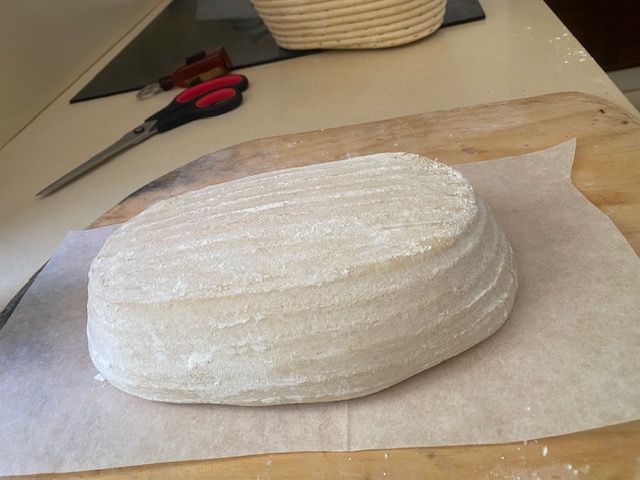
Interesting experiment & advice needed
Hello , your wise advice is needed :
Working on improving my Tartine Country bread I am facing a challenge - I am not getting enough "expansion" of the scoring area, seem like it dries up quickly . I did an interesting experiment and scored the bread again after 5 minutes in the oven (yes, I know its against common sense) and .... got another expansion which I think is an indication that the potential is there but I am doing something wrong !
Method of making the bread is pretty standard and following the recipe directions. I cold retard the loaf and bake straight from the fridge on a stainless steel sheet with boiling water tray to create steam.
I am fairly experienced and had great results with other recipes with the same set up.
Attached a pics of different stages, you can see on the surface of the baked loaf the marks of the double scoring (-: 






in my big oven It seems that I had insufficient steam and most of my loaves have didn't expand properly and didn't have that "ear", but after some improvements in steam some started having ears, but I'm still working on getting consistent ears, I think I'm scoring at too shallow of an angle currently and my dough to too sloppy.
But your double scoring method is actually already out there. This method is called the 5 minute score, and basically how it works is that you bake for a short amount of time without the main score to dry out the outer part of dough, so that later it would be easier to score and open up properly. Some people use this method for easier scoring, some use it to protect their decorative scoring, they would score the decorative score first and let it set in the oven, and then add the expansion (main) score so that the designs won't be destroyed by the dough just randomly opening up on a random score.
Oops, I meant to that I think I am scoring at too steep of an angle, not too shallow.
Interesting info, was not aware its a thing
I love dark crusts but the crumb shot shows more dark crust on the upper sides and top as compared to the bottom crust. If your bottom crusts are lighter, you might want to figure out why. One suggestion might be to Lower the temp radiating from above the bake as this might be why the crusts are setting too early.
I find the double score attractive on the above loaf. If it works, why not?
The dark crust is something I aim to get ( my family likes the taste) by letting some air into the oven in the last 5 minutes of baking ( by putting a wooden spoon in the oven door (-: )
I was able to get great results and oven spring (pic attached) in the same oven with many other recipes (lower hydration though) , but from some reason its not working for the Tartine recipe, which I can't figure out why ...
Question : Maybe in higher hydration doughs the crusts sets MORE quickly ? my intuition is the opposite, but ..
Higher hydration doughs probably dry slower than lower hydration, but higher hydration doughs are more sloppy and therefore it can be harder for the dough to be scored and open properly. One option to overcome the sloppyness is to bake straight from cold, doughs are stiffer when cold and so the unbaked ear can hold itself up more. Or, use the 5 minute score as you have found, it dries out the outside and makes it stiffer and easier to get a proper ear.
Thanks, I read some literature and talked to several people - actually higher hydration breads crust seem to form FASTER and not slower .... it would be interesting to hear an explanation why ?
Definitely counter-intuitive. But people tend to repeat what they've heard others say, which may or may not be reliable.
You also need to remember that home ovens are not like professional bread ovens. And my oven, which leaks steam like a sieve, probably doesn't bake like the OP's whose oven he said contains the steam very well, and it doesn't bake like it would if I used a Dutch oven. So it's hard to generalize claims like "higher hydration breads crust seem to form FASTER and not slower " even if they are true for one person with one kind of setup.
OTOH, I personally tested out a different counter-intuitive claim and found that it was so. The claim is that if you fill an ice cube tray (remember those?) with hot water, it will freeze into cubes faster than if you fill it with cold water. I tried that multiple times and it was so. I still don't understand...
lol .... your are spot on .... had a good lough on the ice cube thing... in my case, I am sure the crust is forming too quickly as the double score experiment prove ... every bread and every set up is different , you are right about it ..
What I do is to let the loaf spend its last 15 minutes of proof uncovered. That lets the surface dry out enough to score easily and hold that shape as the bake gets going. Note that I usually proof free-standing, but it could work for proofing in a banneton as long as the loaf won't spread out too much during the drying-out period.
TomP.
About the depth and angle of the cuts: try making them deeper or at an angle (around 40-45 degrees) instead of straight. That might help the dough open up better.